Enhanced TDS
Identification & Functionality
- Chemical Family
- Fillers Included
- RTU Product Type
- Technologies
- Product Families
Features & Benefits
- Labeling Claims
- Ready-to-Use Product Features
- Product Properties
- Void-free epoxy resin castings exhibit outstanding resistance to mechanical, thermal and electrical stress even under long-term loading.
- Low cure shrinkage allows the manufacture of large-volume castings and the crack-free encapsulation of metal parts and conductors.
Applications & Uses
- Composites Processing Methods
- Cure Method
- Product End Uses
- Markets
- Applications
- Applications
Indoor electrical insulators for medium and high voltage applications, such as instrument transformers, switchgear components and for structural parts for equipment subject to high mechanical, thermal or chemical stress.
Properties
- Physical Form
- Product Data (Guideline Values)
Unmodified, Bisphenol A based epoxy resins with viscosities and reactivities closely tailored to complement the properties of the recommended hardeners. They contain no solvent and are odourless solids at room temperature
Property Araldite B41 Araldite B46 Unit Test Method Condition Viscosity at 120°C 450 - 580 850 - 1050 mPa*s ISO 3219 at 120°C Viscosity increase (120°C/24h) < 12 < 12 % ISO 3219 at 120°C for 24h Melting range 35 - 50 35 - 50 °C ISO 11357 Epoxy content 2.55 - 2.70 2.30 - 2.45 equiv./kg ISO 3001 Flash point > 200 > 200 °C ISO 1523 Density at 25°C 1.15 - 1.25 1.15 - 1.25 g/cm³ ISO 1675 at 25°C Volatile content < 0.2 < 0.2 % ISO 3251 Vapour pressure at 150°C (Knudsen) appr. 1 appr. 1 Pa at 150°C Aspect (resin solid) pale yellow or yellow pale yellow or yellow - Carboxylic acid anhydride based curing agents which are odourless solids at room temperature.The hardeners Aradur HT 901 and HT 903CI are sensitive to moisture, absorption of which leads to the formation of acid that detrimentally affects the reactivity of the mix and the end properties of castings
Property Aradur HT 901 Aradur HT 903CI Unit Test Method Condition Melting range 128 - 132 77 - 78 °C ISO 11357 - Flash point 140 135 °C ISO 1523 - Density at 25°C 1.48 - 1.53 1.48 - 1.53 g/cm³ ISO 1675 at 25°C Density at 130°C 1.22 - 1.25 1.22 - 1.25 g/cm³ ISO 1675 at 130°C Vapour pressure at 130°C (Knudsen) appr. 800 appr. 500 Pa - at 130°C Acid content < 1.1 < 1 % ISO 7327 - Aspect White powder White flakes - - - Accelerator DY 068
Low-viscosity, carboxylic acid anhydride based catalyst containing cure-accelerating agents. Addition of this accelerator to a resin-hardener combination results in a highly reactive mix primarily suitable for processing by the pressure gelation method.
Property Value Unit Test Method Condition Viscosity at 25°C < 300 mPa*s ISO 12058 at 25°C Density at 25°C 1.15 - 1.20 g/cm³ ISO 1675 at 25°C Flash point 172 °C ISO 1523 Vapour pressure at 110°C (Knudsen) appr. 100 Pa at 110°C
Technical Details & Test Data
- Conventional Casting Information
Mix ratios
Material System 1 System 2 System 3 System 4 System 5 System 6 ARALDITE® B 41 100 100 - 100 100 - ARALDITE® B46 - - 100 - - 100 ARADUR® HT 903 30 30 30 - - - ARADUR® HT 903CI - - - 40 40 40 Silica Flour W12 - 200 200 - 200* 200* * A filler loading of up to 250 part pbw (64%) would be feasible
Pretreatment of resin, addition of filler
ARALDITE® B41 or B46 is heated to obtain a clear, liquid melt to which the, usually, preheated and degassed filler and the required amount of colouring paste are added. This mix is degassed under constant stirring prior to adding the hardener. The following guidelines apply :
Property Unfilled Filled Resin Melt Temperature ca. 130°C ca. 150°C Filler Preheating Temperature - 130 - 150°C Degassing at 0.5 - 3 mbar 0.5 - 3 mbar 0.5 - 3 mbar Mix Time Under Vacuum 1/2 - 1h 1 - 3h Addition of cold hardener
Hardener Aradur HT 901 or HT 903-1CI is added when the mixer is stopped. The mixing chamber is then again put under a vacuum, the vacuum line closed off, and the mixer put in motion. To ensure rapid and complete melting of the hardener the following requirements should be met.
Property ARADUR® HT 903 ARADUR® HT 903Cl Required End Temperature of Total Mix 130 - 135°C 100 - 120°C Temperature of Resin/Filler Mix 140 - 150°C 120 - 140°C Vacuum at 100°C appr. 1 mbar - Vacuum at 110°C appr. 2 mbar - Vacuum at 120°C appr. 5 mbar - Vacuum at 130°C ca. 8 mbar - Mix Time Under Vacuum 10 - 20 min 10 - 20 min Addition of liquefied hardener
- Hardener ARADUR® HT 901 and Hardener ARADUR® HT 903CI can be liquefied at 130-135°C and 90-110°C respectively prior to being added to the resin-filler mix, the temperature of which should be reduced accordingly. Use of liquefied hardener makes it easier to control the temperature of the casting mix.
- Viscosity versus time and temperature
- Systems 2 and 3 at 120°C
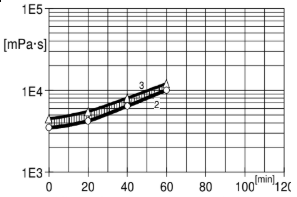
- Viscosity versus time and temperature
- Systems 5 and 6 at 120°C, System 5 at 100°C

- Geltime as a function of temperature (ISO 9396)
- Systems 2 and 3
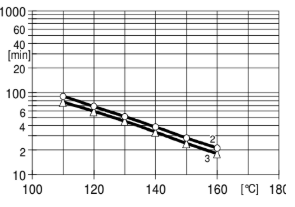
- Geltime as a function of temperature (ISO 9396)
- Systems 5 and 6
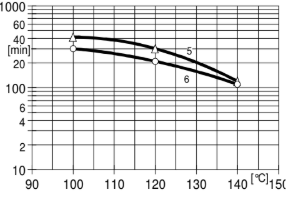
- Glass transition temperature as a function of the cure time (isothermic reaction, ISO 11357-2)
- Araldite B41/B46:HT 901:Silica (100:30:200 pbw)
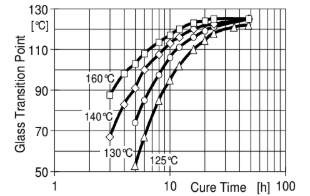
- Glass transition temperature as a function of the cure time (isothermic reaction, ISO 11357-2)
- Araldite B41/B46:HT 903CI:Silica (100:40:200 pbw)
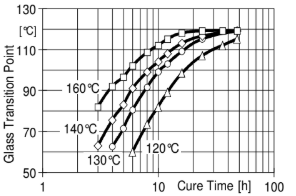
- Processing Methods
- Conventional gravity casting process under vacuum
- The choice of the resin and hardener is determined by the application envisaged and the processing equipment available.
- Pot life and exothermic temperature rise can be controlled by appropriate selection of the resin, hardener and filler combination used.
- System Preparation Information
General instructions for preparing prefilled resin systems
- Long pot life is desirable in the processing of any ARALDITE® casting resin system.
- The ARALDITE® resin melted to 120-150°C, together with the dried filler and eventually further additives, will be first premixed under vacuum in the premixer.
- Internsive wetting of the filler is extremely important. Proper mixing will result in:
- Better flow properties and reduced tendency to shrinkage
- Lower internal stresses and therefore improved mechanical properties on object
- Improved partial discharge behaviour in high voltage applications.
- The quantity of premix needed for a casting operation will be transferred to the final mixer and the appropriate quantity of the ARADUR® hardener (at room temperature) will be added.
- After reaching appr. 5 mbar of vacuum, the vacuum pump has to be turned off. Following, the mixer is turned on. After intensive mixing of appr. 15 min the casting resin system is ready.
- The temperature will decrease to appr. 100-120°C and the vacuum did regulate itself to appr. 8 mbar. Now it can be casted directly into the preheated moulds in the autoclave at 100-120°C and under a vacuum of appr. 10-15 mbar.
- The mixing time of the premix (ARALDITE® resin and filler) can vary from 2 to 6 hours, depending on mixing temperature, quantity, mixing equipment and the particular application. The required vacuum is 0.5 to 3 mbar. The vapour pressure of the individual components should be taken into account.
- In the case of electrically highly stressed parts, we recommend checking the quality consistency and predrying of the filler. The moisture content should be ≤0.2%.
- The mixing time of the premix (ARALDITE® resin and filler) can vary from 2 to 6 hours, depending on mixing temperature, quantity, mixing equipment and the particular application.
- The required vacuum is 0.5 to 3 mbar. The vapour pressure of the individual components should be taken into account. In the case of electrically highly stressed parts, we recommend checking the quality consistency and predrying of the filler. The moisture content should be ≤0.2%.
Specific Instructions- The effective pot-life of the mix is about 1 hour at temperatures below 120°C. Conventional batch mixers should be cleaned once a week or at the end of work.
- Viscosity increase and gel time at various temperatures.
Property Method Condition Mould temperature Conventional vacuum casting at 120 - 140°C Demoulding times Conventional vacuum casting 4 - 8 hours Cure conditions Conventional vacuum casting 10 - 20h at 140°C - For castings with big volume (exothermic reaction, interal mechanical stresses) or encapsulation of heat sensitive active parts could be cured at appr. 80°C.
- To determine whether crosslinking has been carried to completion and the final properties are optimal, it is necessary toc arry out relevant measurements on the actual object or to measure the glass transition temperature.
- Different geling anc cure cycles in the manufacturing process could lead to a different crosslinking and glass transition temperature respectively.
- Mechanical & Physical Properties
Mechanical and Physical Properties
Property System 1 System 2 System 3 System 4 System 5 System 6 Unit Tensile Strength (max.) (ISO 527) 70 - 90 80 - 100 80 - 100 60 - 85 70 - 90 70 - 90 MPa Elongation at Break (ISO 527) 5 - 7 1.0 - 1.4 1.0 - 1.4 5 - 6 1.0 - 1.3 1.0 - 1.3 % E Modulus from Tensile Test (ISO 527) 3700 - 4500 9600 - 10600 9600 - 10600 3700 - 4500 9600 - 10600 9600 - 10600 MPa Flexural Strength (max.) (ISO 178) 100 - 120 130 - 150 120 - 140 100 - 120 120 - 140 120 - 140 MPa Surface Strain (ISO 178) 8 1.7 1.8 9 2 2 % Compressive Strength (max) (ISO 604) 100 - 130 180 - 200 180 - 200 100 - 130 180 - 200 180 - 200 MPa Ball Indentation Hardness (30-sec value) 90 - 100 130 - 150 130 - 150 90 - 105 130 - 150 130 - 150 MPa Deflection (ISO 178) 17 - 19 14 - 19 16 - 22 17 - 19 16 - 22 16 - 22 mm DIN 53452 12 - 14 2 - 3 2 - 3 13 - 15 2 - 3 2 - 3 kJ/m² Impact Strength (ISO 179) 40 - 50 14 - 19 16 - 22 40 - 60 16 - 22 16 - 22 kJ/m² Notched Impact Strength (ISO 179) 5 - 7 2.5 - 3.5 2.5 - 3.5 5 - 7 2.3 - 2.5 2.3 - 2.5 kJ/m² Double Torsion Test (CG 216-0/89) 10.3 14 - 19 16 - 22 10.3 16 - 22 16 - 22 MPa·m¹/₂ Critical Stress Intensity Factor (K1C) 90 - 100 2.2 - 2.4 2.3 - 2.5 80 - 90 2.3 - 2.5 2.3 - 2.5 MPa·m¹/₂ Specific Energy at Break (G1C) 115 - 130 105 - 115 105 - 115 90 - 100 105 - 115 105 - 115 J/m² Photoelastic Constant S 60 - 65 34 - 37 34 - 37 60 - 65 34 - 37 34 - 37 (kg/cm²)/magnitude.cm
Martens Temperature (DIN 53458) 115 - 130 115 - 130 115 - 130 105 - 120 115 - 130 115 - 130 °C Glass Transition Temperature (DSC) 60 - 65 34 - 37 34 - 37 60 - 65 34 - 37 34 - 37 °C Coefficient of Linear Thermal Expansion 0.17 - 1.23 0.80 - 0.90 0.70 - 0.80 0.15 - 0.20 0.70 - 0.80 0.70 - 0.80 K⁻¹·10⁻⁶ Thermal Conductivity at 80°C (ISO 8894-1) 0.28 0.2 0.2 0.28 0.2 0.2 W/m·K Specific Heat 3a 2b 2b 3a 2b 2b kJ/kg·K Glow Heat Resistance (IEC 60707) 350 - 360 350 - 360 350 - 360 350 - 360 350 - 360 350 - 360 class Decomposition Temperature 0.25 - 0.35 0.15 - 0.25 0.10 - 0.20 0.25 - 0.35 0.10 - 0.20 0.10 - 0.20 °C Water Absorption (specimen: 50x50x4 mm, 10 days at 23°C) 0.20 - 0.25 0.10 - 0.15 0.10 - 0.15 0.15 - 0.20 0.10 - 0.15 0.10 - 0.15 % by wt. Water Absorption (specimen: 50x50x4 mm, 30 min at 100°C) 0.10 - 0.20 0.10 - 0.15 0.10 - 0.15 0.10 - 0.15 0.10 - 0.15 0.10 - 0.15 % by wt. Density (ISO 1183) 1.73 - 1.78 1.82 - 1.92 1.74 - 1.79 1.15 - 1.25 1.60 - 1.70 1.60 - 1.70 g/cm³ - Electrical Properties
Electrical Properties :
Property System 1 System 2 System 3 System 4 System 5 System 6 Unit Electric Strength (IEC 60243-1) 21 - 23 23 - 25 23 - 25 21 - 23 23 - 25 23 - 25 kV/mm 90°C/50Hz (IEC 60243-1) 18 23 23 18 23 23 kV/mm Surge Breakdown Voltage (1/50μs) 111 111 111 111 111 111 kV Mean Thickness 3.54 3.16 3.16 3.54 3.16 3.16 mm Mean Field Strength 31.4 35.2 35.2 31.4 35.2 35.2 kV/mm HV Arc Resistance (IEC 61621) L1 L4 L4 L1 - - - Fig.8.1: Loss factor (tan δ) and dielectric constant (εr) as a function of temperature (measurement frequency: 50 Hz, IEC 60250) Systems 2 and 3
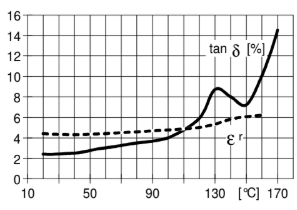
Fig.8.2: Volume resistivity (ρ) as a function of temperature (measurement voltage: 1000 V, IEC60093) Systems 2 and 3
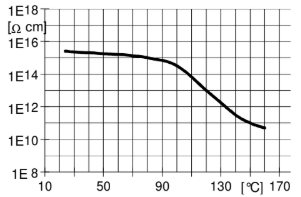
Fig.8.3: Loss factor (tan δ) and dielectric constant (εr) as a function of temperature (measurement frequency: 50 Hz, IEC 60250) Systems 5 and 6
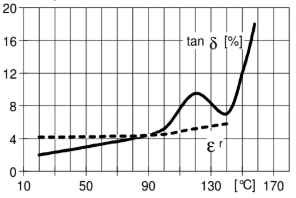
Fig.8.4: Volume resistivity (ρ) as a function of temperature (measurement voltage: 1000 V, IEC 60093) Systems 5 and 6
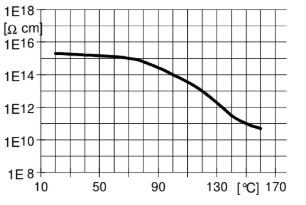
Heat ageing according to ICE 60216
- Determined on standard test specimen
- Cured for 8h at 160°C
Fig.9.1: Weight loss (DIN 16946) (limit: 1.2%) System 2
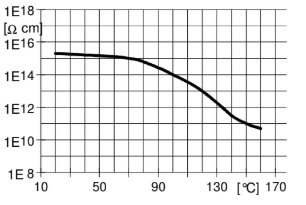
Fig.9.2: Loss of flexural strength (DIN 16946) (limit: 50%) System 2
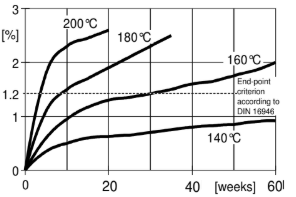
Fig.9.3: Temperature-time curves (derivated from times for end-point criterion) System 2
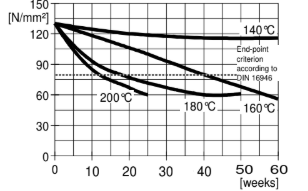
Water absorption (ISO 62)
- Determined on standard test specimen(60x10x4mm)
- Cured for 16h at 140°C
Fig.9.4: Absorption of water as a function of immersion time at 20°c, 40°C, 70°C and 100°C
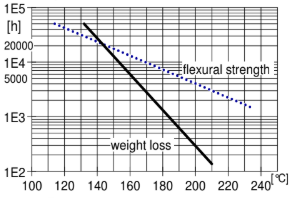
Tensile creep characteristics
- Determined on standard test specimen
- Cured for 16h at 140°C
Fig.10.1:Test temperature 23°C Tensile strength σz (23°C) 87 MPa ( ❒ = failure)
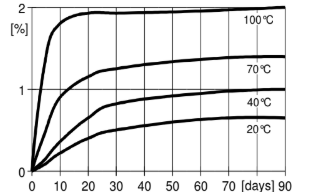
Fig.10.2:Test temperature 40°C Tensile strength σz (40°C) 85 MPa (❒ = failure) System 2
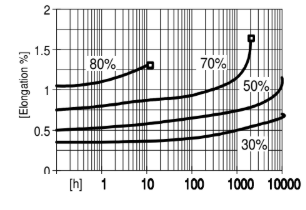
Fig.10.3:Test temperature 85°C Tensile strength σz (85°C) 57 MPa System 2
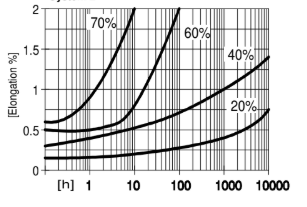
Determined in accordance with DIN 53444 ,The tensile specimens were loaded to give stresses equal to the indicated percentages of the initial short-term failure stresses of the material at the temperatures shown.
- Fillers Information
Fillers
- The addition of powdered mineral fillers such as silica flour, microdol and aluminium oxide is recommended when manufacturing castings that will be required to withstand mechanical, electrical or thermal stress.
The incorporation of mineral fillers
- Modifies major mechanical and electrical properties;
- Reduces shrinkage and exothermic temperature rise during cure;
- Imparts a low coefficient of linear expansion;
- Improves thermal conductivity;
- Reduces unit costs.
- The reduction of elongation at break resulting from the use of filler may be a drawback under certain conditions.
- The glow heat resistance and flame-retarding properties of castings can be enhanced by substituting some part of the silica flour filler with Aluminium Oxide Trihydrate. A slight impairment of mechanical and dielectric properties is acceptable.
- Depending on processing conditions and the application for wich castings are intended, filler loadings of up to 250 parts by weight may be used.
- The data given for filled systems were determined by test specimens containing 210 parts by weight W12 grade silica flour supplied by Quarzwerke GmbH, Frechen, Germany.
- The end properties of a casting are dependent to a marked degree on the type, grade, amount and orgin of the filler incorporated, on the pretreatment it was given, and on the way it was added to the mix. For instance, silanized silica flour filler has been found to impart appreciably more durable dielectric properties to a casting exposed to tropical weathering. Filler should be predried if it is to be used in high performance castings.
- The impurity content of the filler affects the cprocesing properties of the casting resin mix. It is advisable to test the reactivity and exothermic characteristics with every new batch of filler before continuing production.
- The particle size distribution of a filler influences the flow properties of a casting mix, the gel time and the end properties of castings. Test results deviating from those quoted in this Instruction Sheet are to be expected if casting mixes are formulated using fillers other than those show.
- Coarse fillers have an undesirable tendency to settle out, ultimately promoting built-in stresses in castings.
Storage & Handling
- Storage Conditions
- The components have to be stored under dry conditions, in tightly sealed original containers.
- Product specific advise regarding storage can be found on product label.
- Under these conditions, the shelf life will correspond to the expiry date stated on the label.
- After this date, the product may be processed only following reanalysis.
- Partly emptied containers should be closed tightly immediately after use.
